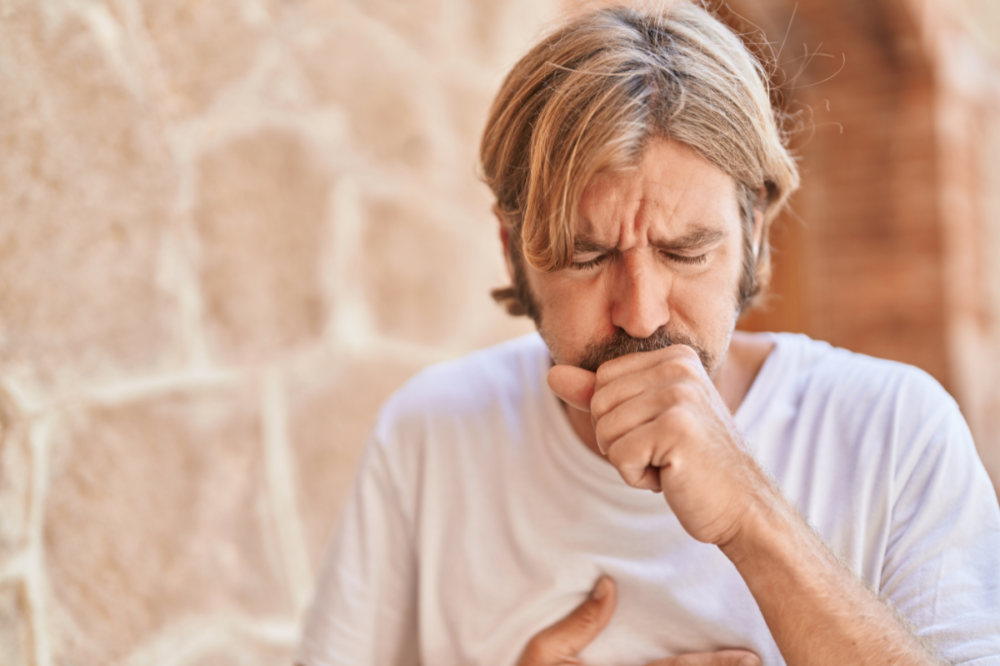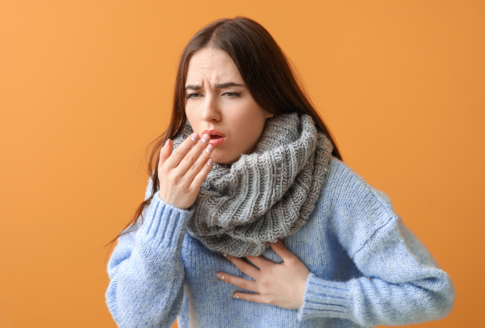COPD: What is Chronic Obstructive Pulmonary Disease, Symptoms & Treatment

Table of Contents
What is COPD?
Chronic Obstructive Pulmonary Disease (COPD) is a common lung disease that includes chronic bronchitis and emphysema.
In bronchitis, there is inflammation and narrowing of the airways, as a result of which the lungs cannot empty normally during exhalation. This condition is usually reversible. On the other hand, in emphysema the structure of the lungs gets damaged.
The worldwide prevalence of COPD in the adult population over 40 years old is close to 10% and appears to affect men more than women.
This long-term disease seems to worsen over time, while it is characterized by periods of exacerbation and remission. In addition, it usually comes with other diseases (comorbidity) and is a serious cause of mortality. Specifically, it is currently the 4th leading cause of death in the world!
Causes
The main risk factor for COPD is smoking, followed by frequent exposure to pollution.
The main causes that contribute to the appearance of Chronic Obstructive Pulmonary Disease are briefly mentioned below
- Cigarette smoke (active & passive smokers)
- Indoor and/or outdoor air pollution
- Genetic predisposition and heredity (eg alpha-1 antitrypsin deficiency)
- Unbalanced and/or inflammatory diet (e.g. Western-style diet)
In addition to smokers, who are at a very high risk of developing this disease, things also appear to be bad for those who have been inhaling harmful substances for many years at the workplace (exposure to pollutants/chemicals/dust) and/or at home.
In addition, it is worth mentioning that exposure to one or more of these risk factors in the first years of life significantly increases the likelihood of future COPD occurrence. Typical examples are the following:
- Lung infections at a young age
- Exposure to polluted air
- Mothers who smoke during pregnancy and after
- Bad eating habits – nutrient deficiencies
Finally, regarding people who have already developed the disease, it is important to emphasize that exposure to the risk factors can cause flare-ups and worsen the patient’s condition.
Symptoms
The main symptoms of COPD are shortness of breath (especially when fatigued) and cough, with or without mucus production. Depending on the intensity and duration of the condition, however, other symptoms and complications are likely to occur.
The most common symptoms are as follows:
- Chronic cough
- Wheezing
- Difficulty taking a deep breath
- Shortness of breath during exercise
- Phlegm
- Chest tightness
Without proper management of the disease or due to exacerbation of symptoms, it is likely that a variety of symptoms will affect the whole body. This can happen because of a high degree of comorbidity and/or because of the chronicity of the condition.
In particular, the following may occur or coexist:
- Fatigue
- Anorexia
- Anxiety, depression
- Weight loss
- Osteoporosis
- Muscle weakness
- Gastroesophageal reflux
- Cachexia
- Cyanosis
- Anemia
- Heart disease
- Diabetes
- Metabolic syndrome
As a rule, the symptoms gradually increase in intensity in those who have had COPD for a long time, as well as in those who also suffer from other conditions.
How is COPD diagnosed?
The diagnosis of COPD is made through a very simple, quick and painless test called spirometry, performed by a pulmonologist.
During this examination, the patient takes a deep breath and then exhales with all their strength, blowing into a device called a spirometer.
It is recommended that all smokers over the age of 40, or those who used to smoke a lot of cigarettes for at least a decade, visit their doctor and perform this test.
It is also worth noting that many people do not realize that they have COPD and are not examined in time, as they consider that the characteristic symptoms of the disease, such as shortness of breath and cough, are due to other factors.
Is COPD treatable?
There is currently no cure for COPD, but its symptoms are greatly manageable if a person follows certain guidelines in their daily life.
In addition, nowadays there are a number of medicines and nutritional supplements available, which can limit the symptoms, slow down the progression of the disease and improve the quality of life.
Available disease management options include:
- Reducing exposure to risk factors (smoking, air pollution)
- Treatment with bronchodilators (prevention of flare-ups)
- Oxygen therapy (facilitates breathing)
- Improving exercise capacity (relieves symptoms)
- Pulmonary rehabilitation programs
The main advice given to people with COPD is to prevent flare-ups and limit the intensity of symptoms. However, improving the quality of life is also of great importance.
Guidelines
With the main advice being to avoid exposure to the various risk factors, below are some practical tips for preventing/slowing down the progression of the disease:
- Avoid or stop smoking (active & passive): Once you stop smoking, the respiratory benefits start to become visible within a few days.
- Avoid exposure to pollutants (fumes, dust)
- Regular physical activity: Daily aerobic exercise is recommended, with a gradual increase in the level of difficulty (e.g. easy walking at first and later running). It has been shown by numerous studies that physical exercise improves the course of the disease and reduces symptoms.
- Balanced diet: It is recommended to follow a healthy diet, such as the Mediterranean diet which is rich in nutrients, while it is recommended to avoid the consumption of junk food, processed foods and alcohol.
- Maintaining a healthy body weight: It is important to stay within a healthy body weight range, as not only obesity but also very low body weight can worsen disease progression & symptoms.
- Social life: Be sure to spend enough time with your family and friends, whether at home or outside, doing activities that fill you up!
Natural treatment
As mentioned above, there are various natural ways to prevent and help manage COPD symptoms, such as a healthy diet, nutritional supplements, physical activity and breathing exercises.
1. Diet
Consume daily:
- Fresh fruit and vegetables
- Whole grain food
- Food rich in healthy fats (e.g. olive oil, nuts)
Furthermore, you should regularly consume fish & poultry.
Avoid the following:
- Fast food
- Food high in saturated fats
- Sugar (e.g. candies, sugar, soft drinks)
- Red meat and processed meat (sausages, bacon, etc.)
It is important to consume alcohol in moderation (e.g. a glass of wine once a week).
You should have 3-6 meals daily (depending on portion size), avoiding highly indigestible foods such as hot/spicy foods. Variety is also very important, so that the daily needs of essential nutrients (eg vitamins, minerals) are covered with certainty.
2. Herbs & nutritional supplements
According to several recent studies, the great importance of vitamin, mineral & trace element sufficiency is confirmed, as well as the protective role of substances with antioxidant & anti-inflammatory action!
Many patients are therefore recommended to take nutritional supplements, which contain one or more of the following ingredients:
- Vitamin D
- NAC (N-Acetylcysteine)
- Antioxidant formulas (vitamins A-C-E, selenium, zinc, carotenoids, etc.)
- PUFAs (polyunsaturated fatty acids) such as Omega 3 fats
- Melatonin
- Vitamin B12
- Weight loss formulas (indirect benefit)
- Multivitamins (in case of nutrient deficiencies)
Herbs that help with COPD are the following:
- Crocus sativus L.
- Thyme
- Licorice root
- Panax ginseng
- English ivy (Hedera helix)
- Curcumin
3. Exercise
Even if you are scared to engage in regular physical activity, because of the shortness of breath and intense fatigue that you may experience, it is important to know that it will be worse – in terms of the course of the disease – if you decide to remain physically inactive.
Some exercise options for people with COPD include:
- Walking (30 minutes daily)
- Going up and down the stairs
- Gardening and housework
- Swimming
- Jogging
- Weight lifting – resistance exercise
- Stretching (10 minutes daily)
- Breathing exercises – breathing with “pursed lips”
It is suggested to discuss with your doctor which types of exercise are suitable for you, and it is recommended to stop exercising if you feel:
- dizziness
- unexplained fatigue
- increased wheezing
- feeling of heaviness in the chest and/or
- severe muscle or joint pain
Living with COPD
It is of high importance, in addition to regular physical exercise and following a healthy diet, to find ways to make your daily life easier and to keep in touch with the people close to you.
Try to keep the air in your indoor space clean and to think of practical solutions that will make household chores easier to do, so as to prevent extra fatigue on a daily basis.
It is also of great importance that you do not hesitate to ask for help, would you need it, while it is recommended that you do not stay locked up at home all the time and go on leisure trips as much as you can.
Finally, you should not neglect visiting to your doctor (at least 2 times a year), who is likely to examine you with a stethoscope and also carry out one or more of the following tests to assess the course of the disease:
- Spirometry
- Oximetry
- Chest X-ray
- Six-minute walk test
- QOL (Quality of Life) questionnaire
We therefore conclude that with an appropriate lifestyle and gradual changes in everyday life, prevention and better treatment of the disease is achieved!
At Vita4you.gr you will find supplements for the respiratory system and for bronchitis.
References:
Disclaimer
The content of this blogspot is not and can not be considered as medical advice, diagnosis or treatment. All information is provided to readers solely for informational purposes. There is no intention to substitute this content for personalized medical advice, diagnosis, prognosis or treatment.








Leave a comment